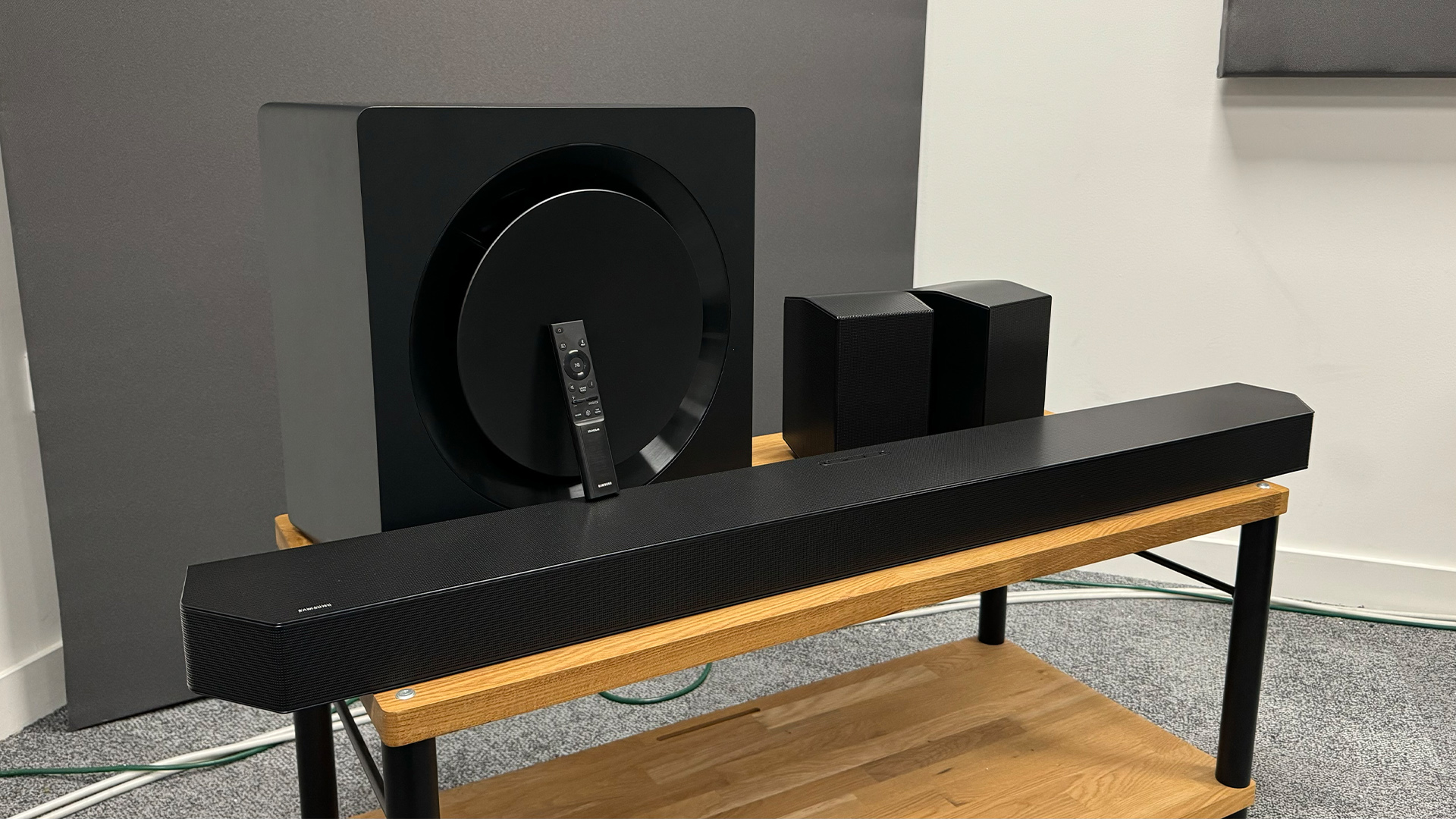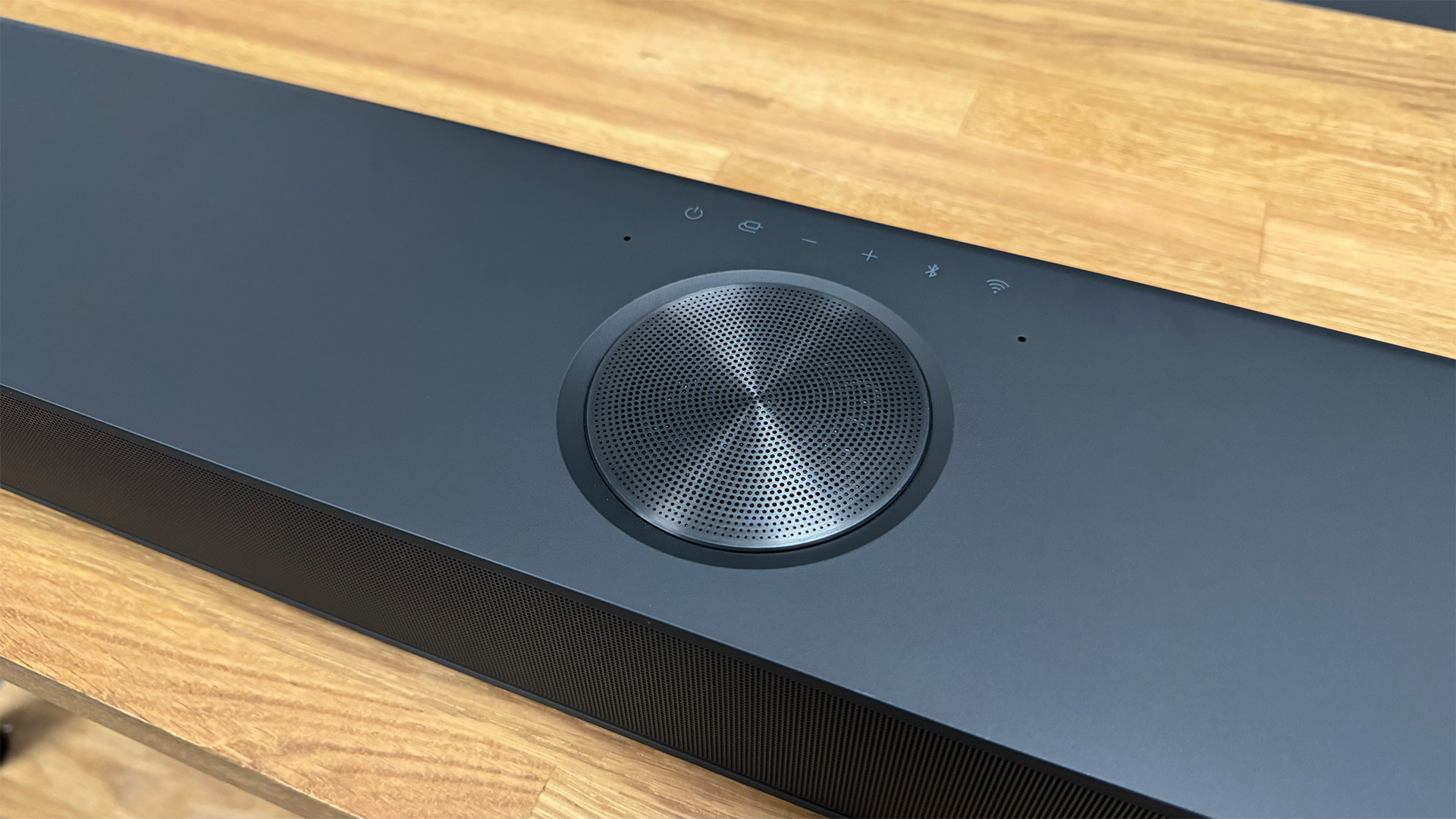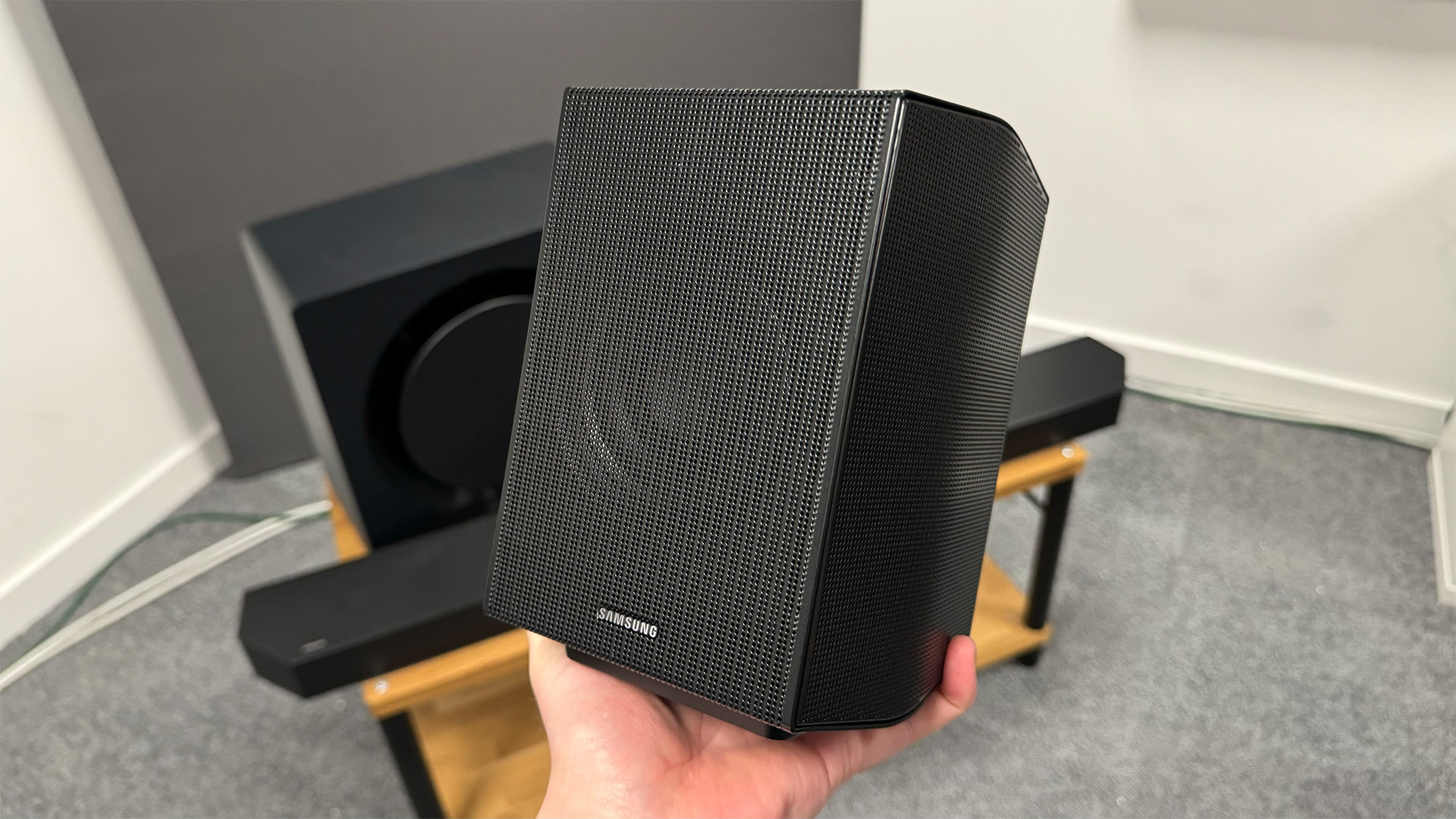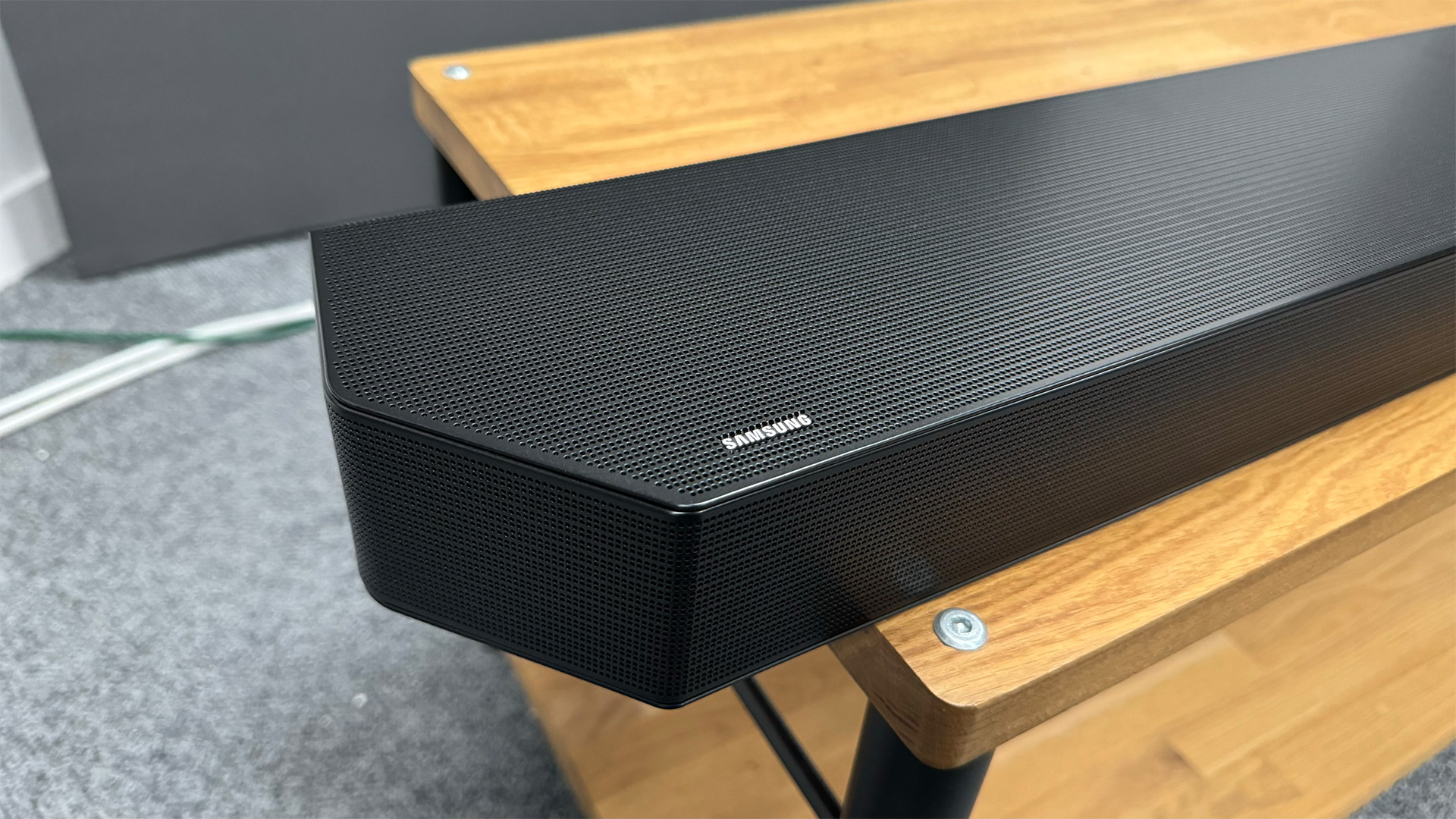
Connectivity: HDMI out (eARC), 1 x HDMI 2.1 in, optical, wi-fi, Bluetooth, Chromecast, AirPlay 2
Format support: Dolby Digital, Dolby Atmos, DTS Surround, DTS:X
Soundbar dimensions (hwd): 6.3 x 125 x 14 cm
Soundbar weight: 5.7kg
LG's S95TR is a decent effort, but it's not in the same league as the HW-Q990D. Sonically it lacks dynamics and excitement, and the subwoofer really isn't up to the task. It might offer a similar level of features as the Samsung, but for less money you can get a far better experience.
For
- Reasonably punchy and detailed sound
- Very open and spacious
- HDMI 2.1 passthrough
Against
- Tonal inconsistencies between ’bar and surrounds
- Lack of three-dimensionality to sound
- Occasionally overbearing and waffly bass
Connectivity: HDMI out (eARC), 2 x HDMI 2.1 in, optical, wi-fi, Bluetooth 5.0, AirPlay 2
Format support: Dolby Atmos, Dolby TrueHD, Dolby Digital Plus, DTS:X
Soundbar dimensions (hwd): 6.9 x 123 x 14 cm
Soundbar weight: 7.7kg
More HDMI sockets, more excitement, more three-dimensionality to the sound, a more composed bass weight... the Samsung HW-Q990D just gives you more. And it costs less than the LG too. Decision made.
For
- Large, immersive and three-dimensional sound
- Dynamic, weighty and detailed
- Two HDMI 2.1 inputs
Against
- Very occasional bassy crackle
- Hard-to-read display
Samsung and LG are the two biggest TV manufacturers in the world, but they also make soundbars. Unsurprisingly, their models work best when partnered with a TV from the same brand, but they are also compatible with other makes.
Samsung's HW-Q990D earned five stars from us when we tested it over the summer. And now there's a nigh-on identical competitor in the form of the LG S95TR – both comprise a soundbar, two wireless speakers and a wireless subwoofer, both support similar formats, have similar specs and launched around the same price. But which is better?
Samsung HW-Q990D vs LG S95TR: price
The Samsung HW-Q990D launched at £1699 / $2000 / AU$2099, but has come down in price since then. It currently costs £1249, but has dropped as low as £1169 at Amazon.
The LG S95TR launched in September 2024 for £1699 / $1500 / AU$1699, but it too has had a price cut, albeit a much smaller one. It currently sells on Amazon for £1531, and is cheaper from the get go in the US and Australia.
Look out for deals on both come the big sales events later in the year. The S95TR has also been bundled free with the LG G4 OLED TV from certain retailers, although only at the 83 and 97-inch screen sizes.
** Winner: Samsung HW-Q990D **
Samsung HW-Q990D vs LG S95TR: design

Neither of these soundbars rewrites the rulebook in terms of design, but they both do the job. The Samsung Q990D looks almost identical to the Q990C it replaces – it's an angular monolith that could look a bit dated or brutalist for some aesthetics. But for our money it's perfectly inoffensive, and the 7cm height means the bar shouldn't obstruct your TV screen. The LG is slightly shorter (6.3cm) but wider (125cm to 123cm).
The Samsung's thin isolating feet might be too far apart and too shallow for some cabinets, but it does come with isolation pads so you can sit the 'bar on the base of your TV's pedestal stand. It also comes with brackets for wall mounting the 'bar (though you'll need to buy your own for the satellite speakers).
The Samsung's screen could be a lot better. It's a small dot matrix affair with room for just three characters at a time, which means text has to scroll across it. It's not ideal. But at least it has a screen, unlike the LG, which relies on three LEDs to tell you what it's up to. Both soundbars can be controlled via their respective mobile apps.
The LG soundbar looks more svelte thanks to its rounded corners, but it's less practical. Not only does it lack a screen, but its bundled power cables for the satellite speakers are much shorter than the Samsung's. Though the Samsung's HDMI ports are a bit awkward to access.
Both have their negatives from a design standpoint then, but the Samsung is just that bit more practical and easy to use.
** Winner: Samsung HW-Q990D **
Samsung HW-Q990D vs LG S95TR: features

The Samsung HW-Q990D is an 11.1.4-channel system, with 22 drivers in total. Inside the 'bar are six elliptical midrange drivers and three tweeters that fire forwards, plus four side-firing drivers and two up-firers. Each surround speaker has one forward-, one side- and one up-firing driver, and the subwoofer has a 20cm driver hidden behind its plastic plate. Samsung advises that you place the surrounds behind the listening position at an angle of 130-150 degrees, but if you don't, it can use Samsung’s SpaceFit automatic calibration to compensate.
It has four audio presets (Standard, Surround, Game Pro and Adaptive Sound), and like the LG it supports Dolby Atmos and DTS:X (as well as the surround versions of both technologies). It has a number of extra modes too: Active Voice Amplifier (which "analyses external noise in real-time while the soundbar is playing, so that voice audio can always be heard clearly"), Voice Enhancement, Bass Enhancement, Night Mode (reduces bass and dynamics to not disturb others) and Virtual. You can also control the subwoofer's volume independently.
Both of the Q990D's HDMI inputs and its eARC-capable output are certified 2.1, with support for gaming features such as 4K/120Hz, VRR and ALLM. This is a huge boon to gamers underserved by a TV with only two HDMI 2.1 sockets, as it lets them plug in more games consoles or gaming PCs simultaneously. The Q990D also passes through Dolby Vision signals (even though Samsung's own TVs don't support it) as well as HLG, HDR10 and HDR10+.
It's well served by wireless technologies, too, with Chromecast, Spotify Connect and Bluetooth all on board. Partner the Q990D with a Samsung TV and you can tweak the soundbar's settings on the TV screen. And, using the Q Symphony feature, the TV's speakers will work with those in the soundbar to provide even more audio power.
Although the LG S95TR might look very similar, it has a different speaker arrangement. Its 9.1.5-channel configuration includes a central up-firing speaker, and four more up-firers (two more on the ’bar and one on each of the wireless surrounds), alongside the subwoofer and more traditional drivers. LG claims its 'Triple Level Spatial Sound' "adds a virtual layer to create a sound dome around you of richer sound". Though it only kicks in using certain sound modes.
There's only one HDMI input to the Samsung's two, but it is certified HDMI 2.1, with all the features that entails. Wireless tech includes Spotify Connect, Tidal Connect, Google Cast and AirPlay 2.
Connecting it to an LG TV unlocks some exclusive features: WOWCAST allows for a wireless connection between the soundbar and TV; WOW Interface integrates many of the soundbar’s controls into the TV’s menus (making up for the lack of a screen on the 'bar itself); and WOW Orchestra combines the soundbar’s speakers with those of the TV (just like Samsung's Q Symphony).
** Winner: Samsung HW-Q990D **
Samsung HW-Q990D vs LG S95TR: sound

Samsung's HW-Q990D is a five-star product, so it's hardly a surprise to hear that it sounds great. Its SpaceFit calibration works well, raising the surrounds to a level near that of the soundbar and making for a more atmospheric and enveloping experience.
As to which mode is best, it's a close call between Surround and Adaptive. The latter is more forthright, but can occasionally exaggerate certain effects, which can be a bit distracting. Surround mode is a bit more composed, but still very lively, making for some thrilling action scenes. It's punchy yet precise, with plenty of bass weight thrown around.
Atmos effects fill the room and are placed with an impressive level of precision. Low-volume dynamics are handled with skill, and dialogue remains clear throughout. It also has a way with music, making a decent fist of separating the various strands and spreading a stereo signal around the system's 11.1.4 channels – the result is full-bodied, dynamic and clear.
The LG S95TR fares significantly less well, especially with music. It defaults to the AI Sound Pro setting, up-mixing a track's stereo signal and sending it to all channels. It's not good, adding a strange echo to the vocal and a general harshness to the instrumentation. Thankfully, you can disable this mode, but the dedicated Music mode over-eggs the bass and muddies the vocals. Standard mode fares better, with more spaciousness, clearer vocals and more precise instrumentation, though it's still a fair way behind the Samsung.
To movies, then, and here things improve a little. Cinema mode offers LG's 'Triple Level Spatial Sound', which is meant to create a dome of sound with increased height, but the effect isn't very pronounced. There is some extra height, but not very often, and nowhere near as much as with the Samsung HW-Q990D.
Standard mode doesn't isolate and project voices as much as Cinema mode, but the overall delivery is more cohesive. There's a decent amount of sonic detail and dynamic variance on show, and the soundstage remains open and spacious. But the iffy height effect and tonal mismatch between the soundbar and surrounds really hampers the performance. The soundstage lacks depth, with no effects sounding further away than others.
The subwoofer isn't a patch on the Samsung. Its occasional waffly chuffing proves distracting, and it lacks tonality and control. It's all a bit messy and overbearing.
** Winner: Samsung HW-Q990D **
Samsung HW-Q990D vs LG S95TR: verdict
There can only be one winner, and it's the Samsung. The Q990D is currently cheaper, has a more practical design and just sounds miles better.
The LG isn't without its charms – it looks sleeker, and if you own a compatible LG TV it will give you plenty of extra features. It has been known to come bundled with certain models of LG TV too, and for free, we definitely wouldn't turn it down. But for those of us spending our own money, the Q990D is the better bet all round, and by quite some margin.
MORE:
These are the best soundbars
The best Dolby Atmos soundbars
And the 30 best Dolby Atmos scenes to test your home cinema system







